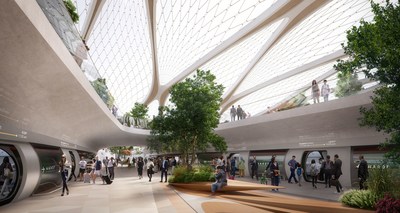Hyperloop, Revolutionising Public Transport - From Amsterdam to Frankfurt in 53 Minutes
AMSTERDAM, September 13, 2018 /PRNewswire/ --
UNStudio partners with Hardt Hyperloop and presents its vision for the Station of the Future.



(Photo: https://mma.prnewswire.com/media/743702/UNStudio_Hardt_Hyperloop.jpg )
(Photo: https://mma.prnewswire.com/media/743703/UNStudio_Hardt_Hyperloop.jpg )
(Photo: https://mma.prnewswire.com/media/743704/UNStudio_Hardt_Hyperloop.jpg )
The UNStudio Futures Team yesterday presented its vision for the 'Station of the Future' at the first edition of HyperSummit, which took place in Utrecht, the Netherlands and was organised by Hardt Hyperloop.
Global urbanisation, population growth and urgent environmental concerns create infrastructural challenges that cannot be resolved with our current modes of transport. A sustainable alternative to air travel is therefore imperative.
Ben van Berkel: 'The hyperloop is not only a realistic and viable alternative to flying, it is going to revolutionise travel. It will provide extremely fast direct connections between cities, enabling completely new ways of working and spending our leisure time, which in turn will lead to a multitude of economic, environmental and knowledge exchange benefits.'
Using technology powered by solar panels, hyperloop will produce no sound or environmental emissions and can provide the necessary energy to power itself. It will be the first ever 100% electric transport system that can safely transport a high volume of passengers from city to city at unprecedented speeds and journey times.
Transfer Hubs - the Stations of the Future
UNStudio's Futures Team was invited to join the Hardt Hyperloop Implementation Programme in order to create a vision for the urban integration of the hyperloop in cities and towns of different sizes and in different locations within these cities: city-centre, edge of city or adjoining an existing infrastructure hub, such as an airport.
Modularity and connectivity at all scales
Commitment to connected modularity is at the core of the hyperloop system and also forms the basis of UNStudio's vision for the hyperloop stations. From platforms to functional spaces and to the roof which extends out over the transfer hubs, a modular design framework organises and connects all parts.
A station powering a region
Hyperloop stations can also act as a batteries for solar energy produced, not only by the station itself, but also along the network. Surplus energy can be used to power the autonomous vehicles, buses and bicycles which passengers can switch to in order to complete their journey.
Unlocking new functions through speed
The hyperloop offers to fulfil a dual purpose, for the fast transport of humans and goods alike. At speeds between 600 and 1000 km/h - it can travel at the same speed as airplanes but deliver passengers to the heart of our cities. This means that the stations themselves can be programmed around the benefits of this speed, incorporating on-demand workspaces, markets for super-fresh, high quality food, picked or caught elsewhere the very same day and even accommodating emergency medical services where time is a crucial factor in saving the life of someone in need.
UNStudio: Ben van Berkel with Ren Yee, Arjan Dingste and Alice Haugh, Jan Sobotka
Advisors: Labscape
Share this article